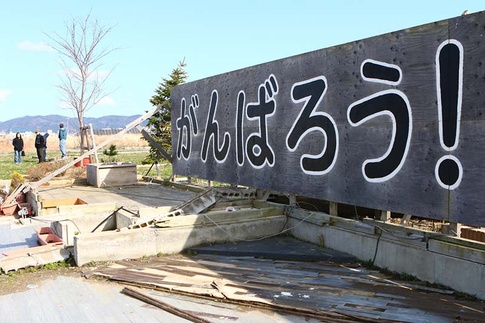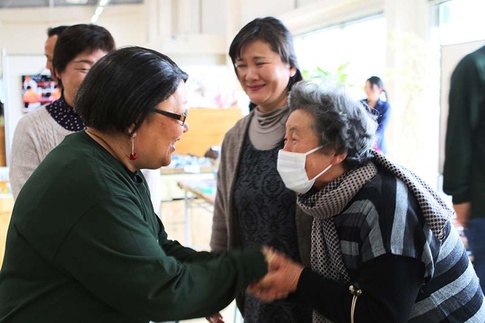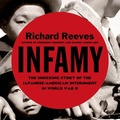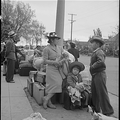“How was your trip to Japan?”
It’s a question I’ve been asked several times since we returned from our Goodwill Tour to Tohoku last month.
“It went really well,” I would say. But after that, I would have a hard time finding the words to describe it.
“It wasn’t like your typical tour of Japan,” said one of our group members.
This is true. We did do some sight-seeing, but the sights to see in the tsunami-affected towns of Minamisanriku and Ishinomaki are not pretty. The debris has been cleared, but what remains is just mile after mile of what used to be: homes, businesses, schools, fishing boats, and everything in between that once made these towns alive are gone, washed away, wiped out.
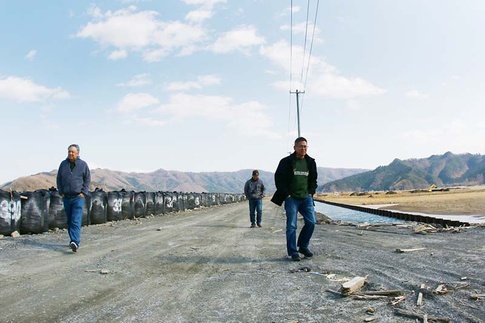
Grateful Crane members (l-r) Soji Kashiwagi, Kurt Kuniyoshi, and Scott Nagatani look out at what used to be. Rice fields used to occupy the land to their left before they got washed away by the tsunami. (Photo by Darrell Miho)
It’s not all like this; there are some parts of Ishinomaki and Minamisanriku that have been rebuilt, and from the window of a tour bus appear to be unaffected. And yet, not far from there are reminders: empty building foundation after empty building foundation, memorials where people bring flowers to pay their respects to family and friends who were lost, and eerie skeletons of buildings serve as everyday reminders of the tsunami’s devastation.
And then, in various locations throughout Tohoku, there are rows and rows of temporary housing communities known as “kasetsu.” These bungalows, similar to those installed in American school parking lots when classroom space runs out, are much better than the tar-papered barracks of World War II. But as Japanese Americans, we couldn’t help but notice that when you line them up in rows they look a lot like “camp.” It’s estimated that over 100,000 people are still living in these temporary housing units.
Tohoku people, we’d been told, are strong. They’re resilient. And they’re tough. They have to be, because what they’ve faced and endured and are still enduring are going to require enormous amounts of strength, resiliency, and toughness today and for many years to come.
These are the people we went to Japan to meet and perform for.
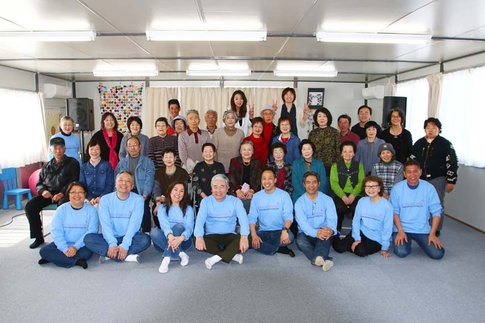
After a performance at a kasetsu in Ishinomaki, members of Grateful Crane took a group photo with the audience members. (Photo by Darrell Miho)
Our group, the Grateful Crane Ensemble, is a non-profit theater company from Los Angeles that traveled to Japan from April 4 to April 14 to sing songs of hope and inspiration for tsunami survivors in Tohoku.
Sponsored by community donations and the Northern Japan Earthquake Relief Fund (NJERF) organized by the JCCCNC in San Francisco, our purpose was to lift the people’s spirits by singing favorite and nostalgic songs. But how would the people in Tohoku react to a group of American “gaijin” coming to their towns to sing for them? Have they ever met a Japanese American before? Do they even know we exist? Most of us Sansei on the trip did not speak Japanese. How was all this going to work?
We didn’t know the answers to these questions as we walked in to perform for the people in temporary housing communities, pre-schools and temporary shopping centers in Ishinomaki and Minamisanriku.
But our performers—musical director Scott Nagatani, Keiko Kawashima, Jason Fong, Haruye Ioka, Darrell Kunitomi, Kurt Kuniyoshi, and Nisei singer Mary Kageyama Nomura—had prepared 33 songs for the tour and were ready for the challenge.
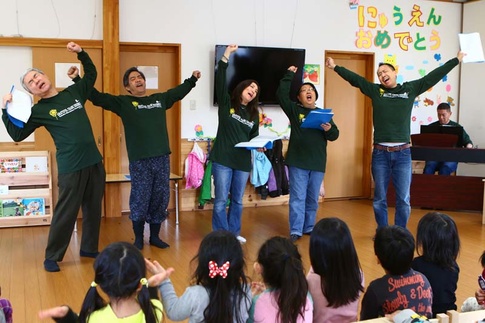
Grateful Crane members (l-r) Darrell Kunitomi, Kurt Kuniyoshi, Keiko Kawashima, Haruye Ioka, and Jason Fong perform a children’s song for kids in Ishinomaki.
Before they sang, however, I gave a brief introductory speech in English, which was read to our audiences in Japanese. I started by saying that I’m a Nikkei from America, and that my grandparents immigrated to the U.S. from Hiroshima and Wakayama. As this was translated to them, many nodded their heads. Hiroshima and Wakayama they knew.
Then I talked about camp, and how our families lost everything. After the war, I told them that many were forced to live in temporary housing for many months. More nodding, many with pained expressions.
But even though our families did not have much after the war, I told them the Issei and Nisei would send box after box—care packages filled with food, clothing, and medicine—to relatives in devastated Japan. It was the Japanese spirit of “otagaisama”: when help is needed, we help each other. I looked at them again; they understood this very well.
When the tsunami hit Tohoku in 2011, I explained that Japanese Americans were deeply touched when we saw how the Japanese people reached out and helped each other. “We saw in you, what had been taught to us,” I said. “When help is needed we help each other. So in the spirit of our parents and grandparents, we are here to carry on our tradition of “otagaisama.” Hearing this, many nodded. They understood. Some wiped away tears.
And then, we sang. We started with nostalgic Japanese songs that they all knew, and after a few songs the ice had been broken and they started to sing and clap along with us. At a kasetsu in Ishinomaki, one 80-year-old man actually got up from his seat in the back, walked up to the front and joined Keiko on stage to sing “Kitaguni no Haru,” a song that’s a huge favorite among the people. This man sang it with great gusto, and to the delight of everyone in the room who knew him.
In all, we did ten performances over five days in the Tohoku area. We sang Japanese songs like “Hana wa Saku” and “Koko ni Sachi Ari,” American classics like “Moon River” and Mary Nomura’s “St. Louis Blues,” and children’s songs for kindergarten kids. As each performance progressed, I could feel an energy transfer from our group members to the people, and back again to our group as the people sang along. By the end of the hour, they were with us and we were with them, and the fact that most of us did not speak Japanese never got in the way. In fact, most of our communication was not through what was said, but what was felt underneath the songs and in our reasons for being there.
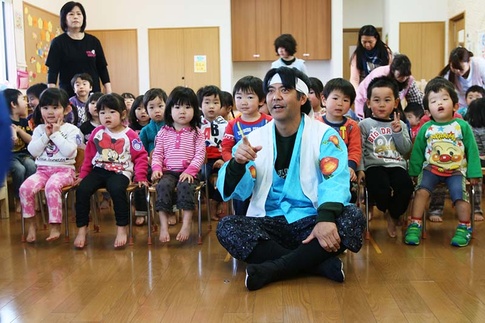
Momotaro (Grateful Crane’s Kurt Kuniyoshi) poses with preschoolers in Ishinomaki. (Photo by Darrell Miho)
We found the people to be strong, tough, and resilient indeed. There was the chef/owner of a restaurant who told us the tsunami was so powerful that it swept up his entire Minamisanriku house—with him in it—and took him on a wild three-mile ride through town. Neko-san from Ishinomaki said that without clean drinking water she was forced to use Coca-Cola to make rice; it tasted bad, she said, but since it was the only thing they had it was good. And then there was Takeyama-san who met us at the remains of Ookawa Elementary School, a tragic site where 74 students—and his parents, who were school volunteers—lost their lives when they were too late in trying to flee the school for higher ground.
It’s been over three years, but their stories of loss are still fresh on their minds and painful. Family members. Friends. They remember them, and the tears flow. And yet, they are doing the best they can to move forward, to rebuild their lives, and to live everyday in memory and in honor of the loved ones they lost.
They called it the “gambarou” spirit. Let’s work hard and get through this together. It’s part of the Japanese spirit and culture; it’s definitely the spirit that keeps the people of Tohoku going. They’re not looking for hand-outs. They want to do this on their own. But sometimes, even the toughest people can use a helping hand and someone to lift their spirits.
“Kandou shimashita,” is a comment that we heard from several people after our performances. It means to be “deeply touched.” One man said he was touched on many different levels. We know there’s power in songs and music. Maybe it was the fact that we came all the way from America. But more than anything, I think it was the idea that someone cared enough to do this for them, and let them know that they are not alone.
“I feel like I have new energy to keep going,” said an elderly woman living in a kasetsu in Minamisanriku, after our performance.
This, along with knowing that we understood what they were going through due to our shared suffering, led one woman, maybe in her early 50’s, to clutch on to my hand after our performance and thank me repeatedly, with tears streaming down her face. That’s when I realized that what was happening ran very deep, beyond any words. All I could do was stand there and cry with her.
As I said earlier, it’s hard to describe this feeling when human beings, in this case through the power of music and song, in combination with empathy and compassion, connect with one another on a deeply emotional and human level. We come from different countries. We speak different languages. But people know and understand love and caring, and when you break it all down, that’s what we were there to share, in the tradition of our Issei and Nisei, on behalf of our community in America, in the land of our ancestors.
“Please don’t forget us,” the people of Tohoku told us.
We won’t. Believe me, we won’t.
© 2014 Soji Kashiwagi


